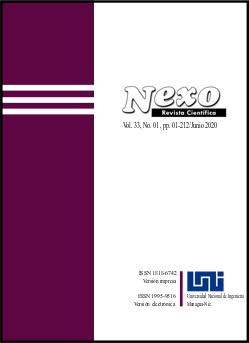The effect of temperature on cement clicker characterızatıon wıth a 10% substıtutıon of basalt stone on limestone mass
DOI:
https://doi.org/10.5377/nexo.v33i01.10055Keywords:
Basalt Stone, Limestone Mass, Cement, TemperatureAbstract
This research was conducted to determine the effect of temperature on the chemical content and crystal structure of the cement clinker with 10% substitution of basalt on the mass of limestone. The cement clinker is made from the composition of limestone, basalt stone, clay, silica stone and iron sand. Basalt stone used came from the East Lampung area. The basalt stone has fulfilled ASTM C618 standard with a total compound of SiO2 + Al2O3 + Fe2O3 of 79.2%. The raw material was then mixed, milled, formed into pellets with a size of 0.8 - 1.4 cm and continued with combustion at calcination temperatures of 1000 ℃, 1100 ℃ and 1200 with a holding time of 2 hours. Based on the results of the XRF test (X-Ray Fluorecence) of the three cement clinker samples with variations in temperature used, the sample is closer to the standard at a temperature of 1000 ℃. For the XRD (X-Ray Diffraction) test results, the three samples have tetragonal, monoclinic, rhombohedral, and orthorhombic crystal structures. As for the MO test results, there was a strong binding between iron sand, limestone, clay, and silica sand characterized by a smooth surface while basalt stones that look like black holes were not completely bound.
Downloads
729
Downloads
Published
How to Cite
Issue
Section
License
The authors who publish in Nexo Scientific Journal agree to the following terms:
- Authors retain the copyright and grant the journal the right of the first publication under the license Creative Commons Attribution License, which allows others to share the work with a recognition of the authorship of the work and the initial publication in Nexo Scientific Journal.
- Authors may separately establish additional agreements for the non-exclusive distribution of the version of the work published in the journal (for example, in an institutional repository or a book), with the recognition of the initial publication in Nexo Scientific Journal.
- Authors are allowed and encouraged to disseminate their works electronically (for example, in institutional repositories or in their own website) before and during the submission process, as it can lead to productive exchanges, as well as earlier and greater citation of published works.











